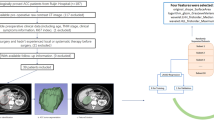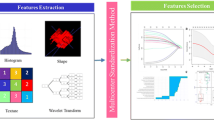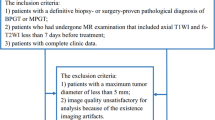Abstract
Background
Proliferative activity prediction is important for determining individual treatment strategies for patients with acromegaly, and tumor proliferative activity is usually measured by the expression of Ki-67.
Objective
This study aimed to assess the value of a magnetic resonance imaging (MRI)-based radiomics approach in predicting the Ki-67 index of acromegaly patients.
Methods
A total of 138 patients with acromegaly were retrospectively reviewed and randomly assigned to primary and validation cohorts. Radiomics features were extracted from MR images, and then the elastic net and recursive feature elimination algorithms were applied to determine critical radiomics features for constructing a radiomics signature. Subsequently, multivariable logistic regression analysis was used to select the most informative clinical features, and a radiomics nomogram incorporating a radiomics signature and selected clinical features was constructed for individual predictions. Twenty-five acromegaly patients were enrolled for multicenter model validation.
Results
Seventeen radiomics features were selected to construct a radiomics signature that achieved an area under the curve (AUC) value of 0.96 and 0.89 in the primary cohort and the validation cohort, respectively. A radiomics nomogram that incorporated the radiomics signature and eight selected clinical features was constructed and showed good discrimination and calibration, with an AUC of 0.94 in the primary cohort and 0.91 in the validation cohort. The radiomics signature in the multicenter validation achieved an accuracy of 88.2%. The analysis of the decision curve showed that the radiomics signature and radiomics nomogram were clinically useful for patients with acromegaly.
Conclusions
The radiomics signature developed in this study could aid neurosurgeons in predicting the Ki-67 index of patients with acromegaly and could contribute to non-invasive measurement of proliferative activity, affecting individual treatment strategies.






Similar content being viewed by others
Data availability
The data used to support the findings of this study are available from the corresponding author upon request.
References
Molitch ME (2017) Diagnosis and treatment of pituitary adenomas: a review. JAMA 317(5):516–524
Melmed S, Bronstein MD, Chanson P et al (2018) A Consensus Statement on acromegaly therapeutic outcomes. Nat Rev Endocrinol. 14(9):552–561
Katznelson L, Laws ER Jr, Melmed S et al (2014) Acromegaly: an endocrine society clinical practice guideline. J Clin Endocrinol Metab 99(11):3933–3951
Colao A, Ferone D, Marzullo P et al (2001) Long-term effects of depot long-acting somatostatin analog octreotide on hormone levels and tumor mass in acromegaly. J Clin Endocrinol Metab 86(6):2779–2786
Salehi F, Agur A, Scheithauer BW, Kovacs K, Lloyd RV, Cusimano M (2009) Ki-67 in pituitary neoplasms: a review—part I. Neurosurgery. 65(3):429–437 (discussion 437)
Baldys-Waligorska A, Wierzbicka I, Sokolowski G, Adamek D, Golkowski F (2018) Markers of proliferation and invasiveness in somatotropinomas. Endokrynol Pol. 69(2):182–189
Trouillas J, Roy P, Sturm N et al (2013) A new prognostic clinicopathological classification of pituitary adenomas: a multicentric case-control study of 410 patients with 8 years post-operative follow-up. Acta Neuropathol 126(1):123–135
Al-Shraim M, Asa SL (2006) The 2004 World Health Organization classification of pituitary tumors: what is new? Acta Neuropathol 111(1):1–7
Lopes MBS (2017) The 2017 World Health Organization classification of tumors of the pituitary gland: a summary. Acta Neuropathol 134(4):521–535
Raverot G, Burman P, McCormack A et al (2018) European Society of Endocrinology Clinical Practice Guidelines for the management of aggressive pituitary tumours and carcinomas. Eur J Endocrinol 178(1):G1–G24
Kasuki L, Wildemberg LE, Neto LV, Marcondes J, Takiya CM, Gadelha MR (2013) Ki-67 is a predictor of acromegaly control with octreotide LAR independent of SSTR2 status and relates to cytokeratin pattern. Eur J Endocrinol 169(2):217–223
Gerlinger M, Rowan AJ, Horswell S et al (2012) Intratumor heterogeneity and branched evolution revealed by multiregion sequencing. N Engl J Med 366(10):883–892
Fan Y, Feng M, Wang R (2019) Application of radiomics in central nervous system diseases: a systematic literature review. Clin Neurol Neurosurg 187:105565
Saeger W, Muller M, Buslei R et al (2018) Recurrences of pituitary adenomas or second de novo tumors: comparisons with first tumors. World Neurosurg. 119:e118–e124
Yu J, Shi Z, Lian Y et al (2017) Noninvasive IDH1 mutation estimation based on a quantitative radiomics approach for grade II glioma. Eur Radiol 27(8):3509–3522
Segal E, Sirlin CB, Ooi C et al (2007) Decoding global gene expression programs in liver cancer by noninvasive imaging. Nat Biotechnol 25(6):675–680
Rutman AM, Kuo MD (2009) Radiogenomics: creating a link between molecular diagnostics and diagnostic imaging. Eur J Radiol 70(2):232–241
Knosp E, Steiner E, Kitz K, Matula C (1993) Pituitary adenomas with invasion of the cavernous sinus space: a magnetic resonance imaging classification compared with surgical findings. Neurosurgery. 33(4):610–617 (discussion 617–618)
Fan Y, Hua M, Mou A et al (2019) Preoperative noninvasive radiomics approach predicts tumor consistency in patients with acromegaly: development and multicenter prospective validation. Front Endocrinol (Lausanne). 10:403
Liu X, Ma S, Yao Y et al (2012) Differential expression of folate receptor alpha in pituitary adenomas and its relationship to tumor behavior. Neurosurgery. 70(5):1274–1280 (discussion 1280)
Di Ieva A, Rotondo F, Syro LV, Cusimano MD, Kovacs K (2014) Aggressive pituitary adenomas—diagnosis and emerging treatments. Nat Rev Endocrinol. 10(7):423–435
van Griethuysen JJM, Fedorov A, Parmar C et al (2017) Computational radiomics system to decode the radiographic phenotype. Cancer Res 77(21):e104–e107
Aerts HJ, Velazquez ER, Leijenaar RT et al (2014) Decoding tumour phenotype by noninvasive imaging using a quantitative radiomics approach. Nat Commun. 5:4006
Wang Q, Li Q, Mi R et al (2019) Radiomics nomogram building from multiparametric MRI to predict grade in patients with glioma: a cohort study. J Magn Reson Imaging 49(3):825–833
Zinn PO, Singh SK, Kotrotsou A et al (2018) A coclinical radiogenomic validation study: conserved magnetic resonance radiomic appearance of periostin-expressing glioblastoma in patients and xenograft models. Clin Cancer Res 24(24):6288–6299
Qu J, Shen C, Qin J et al (2019) The MR radiomic signature can predict preoperative lymph node metastasis in patients with esophageal cancer. Eur Radiol 29(2):906–914
Erturk SM. Receiver operating characteristic analysis. AJR Am J Roentgenol. 2011;197(4):W784; author reply W785
Pan W (2001) Akaike’s information criterion in generalized estimating equations. Biometrics 57(1):120–125
Kramer AA, Zimmerman JE (2007) Assessing the calibration of mortality benchmarks in critical care: the Hosmer–Lemeshow test revisited. Crit Care Med 35(9):2052–2056
Vickers AJ, Cronin AM, Elkin EB, Gonen M (2008) Extensions to decision curve analysis, a novel method for evaluating diagnostic tests, prediction models and molecular markers. BMC Med Inf Decis Mak 8:53
Fedorov A, Beichel R, Kalpathy-Cramer J et al (2012) 3D slicer as an image computing platform for the quantitative imaging network. Magn Reson Imaging 30(9):1323–1341
Fusco A, Zatelli MC, Bianchi A et al (2008) Prognostic significance of the Ki-67 labeling index in growth hormone-secreting pituitary adenomas. J Clin Endocrinol Metab 93(7):2746–2750
Tamrazi B, Pekmezci M, Aboian M, Tihan T, Glastonbury CM (2017) Apparent diffusion coefficient and pituitary macroadenomas: pre-operative assessment of tumor atypia. Pituitary. 20(2):195–200
Mahmoud OM, Tominaga A, Amatya VJ et al (2011) Role of PROPELLER diffusion-weighted imaging and apparent diffusion coefficient in the evaluation of pituitary adenomas. Eur J Radiol 80(2):412–417
Meng X, Xia W, Xie P et al (2019) Preoperative radiomic signature based on multiparametric magnetic resonance imaging for noninvasive evaluation of biological characteristics in rectal cancer. Eur Radiol 29(6):3200–3209
Zhou B, Xu J, Tian Y, Yuan S, Li X (2018) Correlation between radiomic features based on contrast-enhanced computed tomography images and Ki-67 proliferation index in lung cancer: a preliminary study. Thorac Cancer. 9(10):1235–1240
Li Y, Qian Z, Xu K et al (2017) Radiomic features predict Ki-67 expression level and survival in lower grade gliomas. J Neurooncol 135(2):317–324
Xie C, He Y (2016) Spectrum and image texture features analysis for early blight disease detection on eggplant leaves. Sensors (Basel). 16(5):676
Li Y, Liu X, Qian Z et al (2018) Genotype prediction of ATRX mutation in lower-grade gliomas using an MRI radiomics signature. Eur Radiol 28(7):2960–2968
Ugga L, Cuocolo R, Solari D et al (2019) Prediction of high proliferative index in pituitary macroadenomas using MRI-based radiomics and machine learning. Neuroradiology 61(12):1365–1373
Niu J, Zhang S, Ma S et al (2019) Preoperative prediction of cavernous sinus invasion by pituitary adenomas using a radiomics method based on magnetic resonance images. Eur Radiol 29(3):1625–1634
Acknowledgements
We thank H. Nikki March, PhD, from Liwen Bianji, Edanz Editing China (www.liwenbianji.cn/ac), for editing the English text of a draft of this manuscript.
Funding
This work was supported by the Graduate Innovation Fund of Peking Union Medical College (2018-1002-01-10), Natural Science Foundation of Beijing Municipality (Grant No. 7182137), Capital Characteristic Clinic Project (Grant No. Z16100000516092), and Chinese Academy of Medical Sciences (Grant No. 2017-I2M-3-014).
Author information
Authors and Affiliations
Contributions
All authors provided contributions to study conception and design, acquisition of data or analysis and interpretation of data, drafting of the article, or revising it critically for important intellectual content, and final approval of the version to be published. All authors analyzed and interpreted the data. Yanghua Fan, Yi Chai and Kuangxun Li revised the manuscript for important intellectual content. Renzhi Wang and Ming Feng take final responsibility for this article.
Corresponding authors
Ethics declarations
Conflict of interest
The authors declare that they have no competing interests.
Ethical approval
All the patients were informed about the purposes of the study and consequently have signed their “consent of the patient”. All investigations conformed to the principles outlined in the Declaration of Helsinki and were performed with permission by the responsible Ethics Committee of the Institutional Review Board of Peking Union Medical College Hospital.
Informed consent
All participants provided informed consent prior to their participation.
Additional information
Publisher's Note
Springer Nature remains neutral with regard to jurisdictional claims in published maps and institutional affiliations.
Rights and permissions
About this article
Cite this article
Fan, Y., Chai, Y., Li, K. et al. Non-invasive and real-time proliferative activity estimation based on a quantitative radiomics approach for patients with acromegaly: a multicenter study. J Endocrinol Invest 43, 755–765 (2020). https://doi.org/10.1007/s40618-019-01159-7
Received:
Accepted:
Published:
Issue Date:
DOI: https://doi.org/10.1007/s40618-019-01159-7




